kilowattore
Sales Moderator / Section Moderator
Staff member
Moderator Sales
Section Moderator
Certified
I had some free time this weekend and decided to try and post something useful.
I do like building and I do like to shoot pics of watches, luckily for me that's something appreciated on the forums I partecipate, but I felt it still was not enough.
Now, I'm very far from a pro and my experience is quite limited, but some members showed interest in the process I use to age hands so I thought, why not document it?
Here's my effort to explain what I do to those hands and how bad do I treat 'em. I hope it might be useful for new members approaching this hobby.
Let's start
Before anything else, grab a cup of coffee. It's good and you will need it later
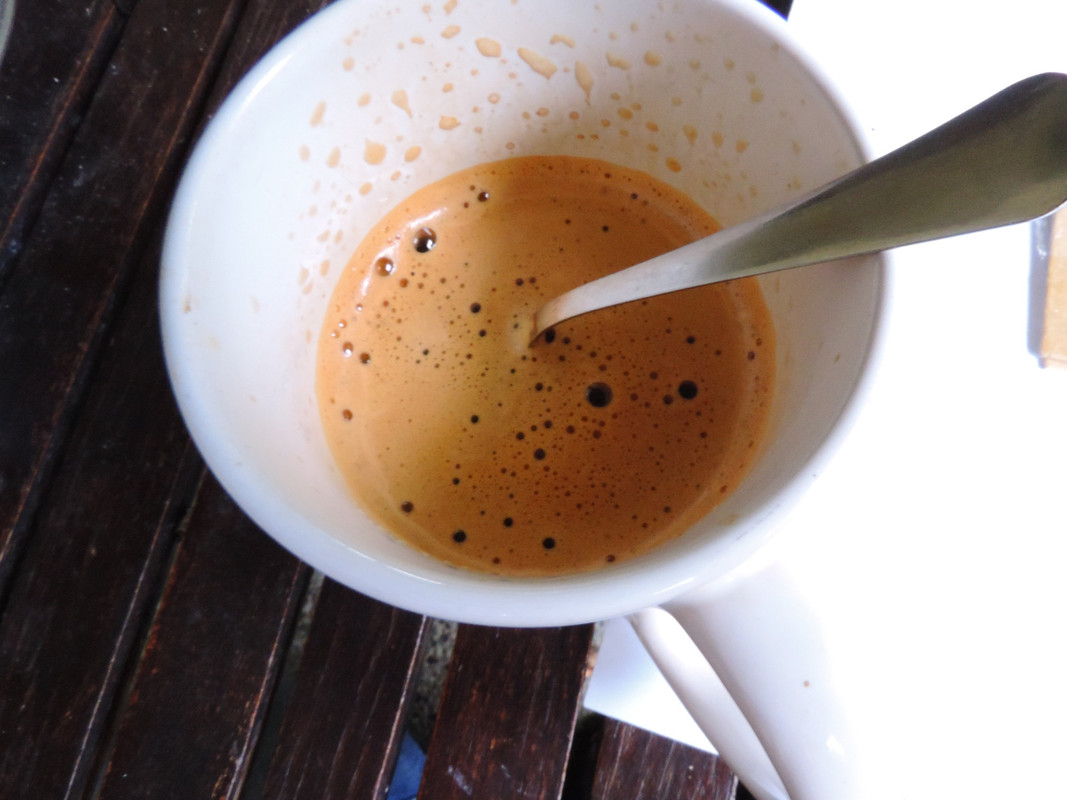
Here's a set of Athaya tall tube hands, we have curved angelus hands, pencil hands and wide hands. This is how they look OOB:
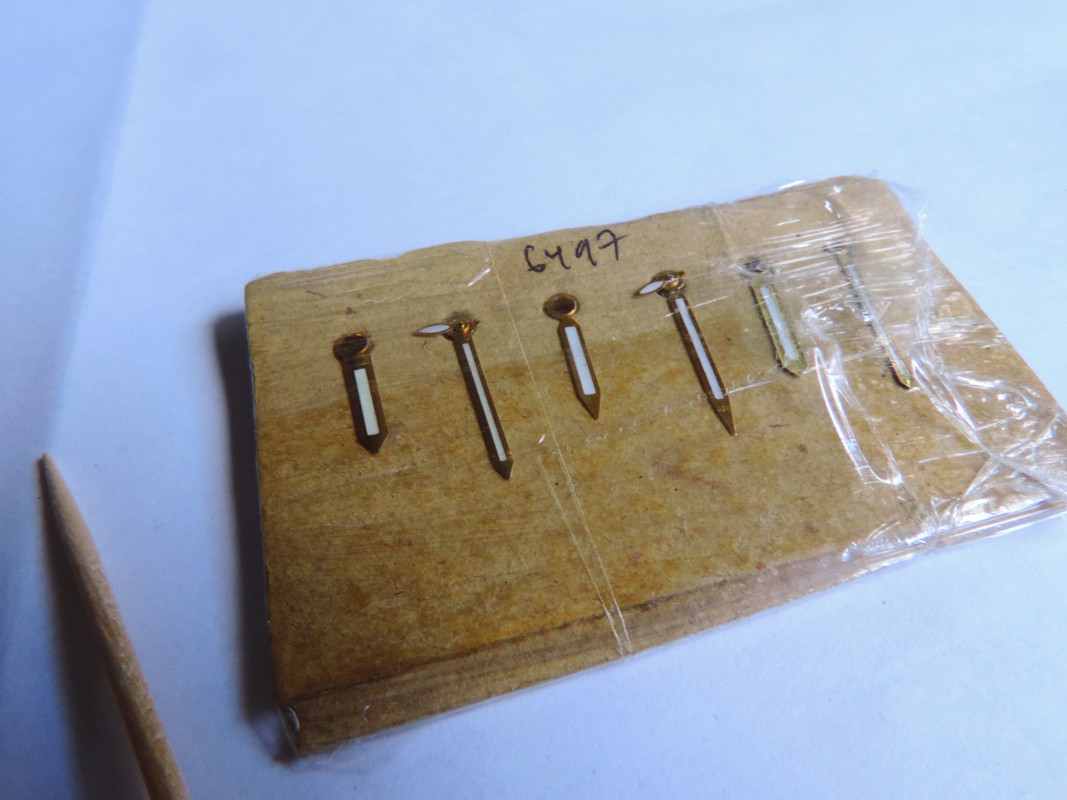
Some "tools" you will need:
- Toothpicks (imho the most essential watchmaker's tool)
- Sandpaper in increasing grades from 180 to 5000 grit cut in small stripes
- A 10x loupe
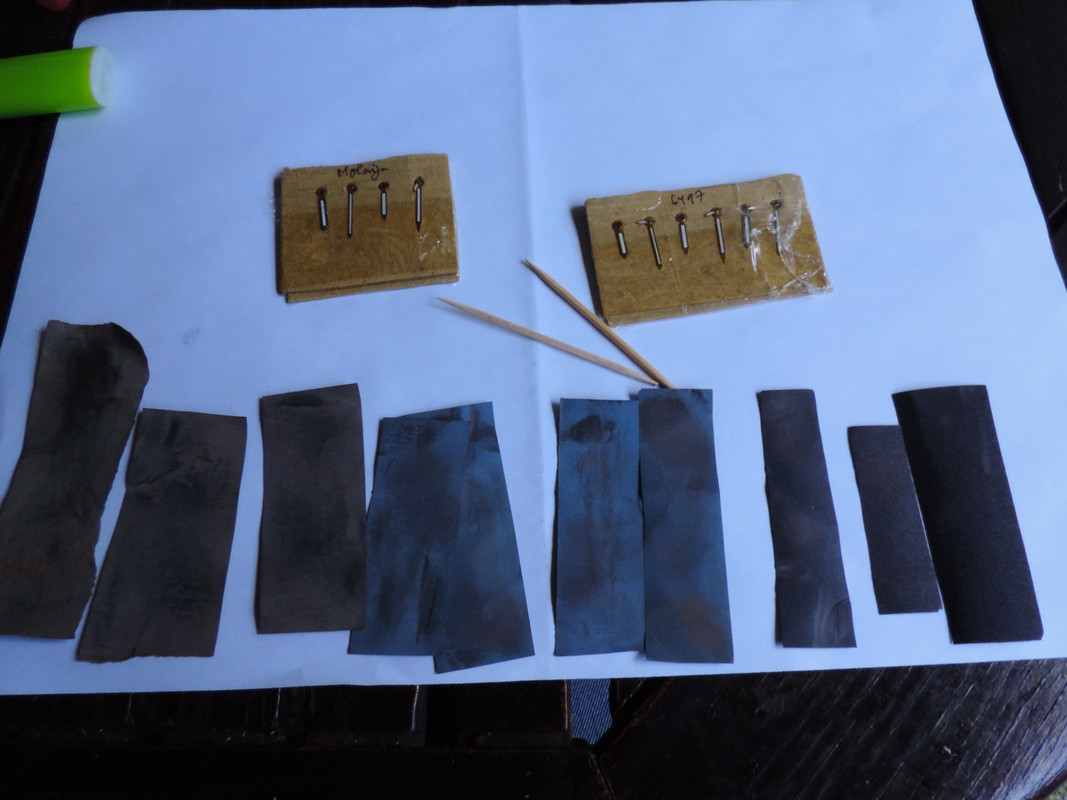
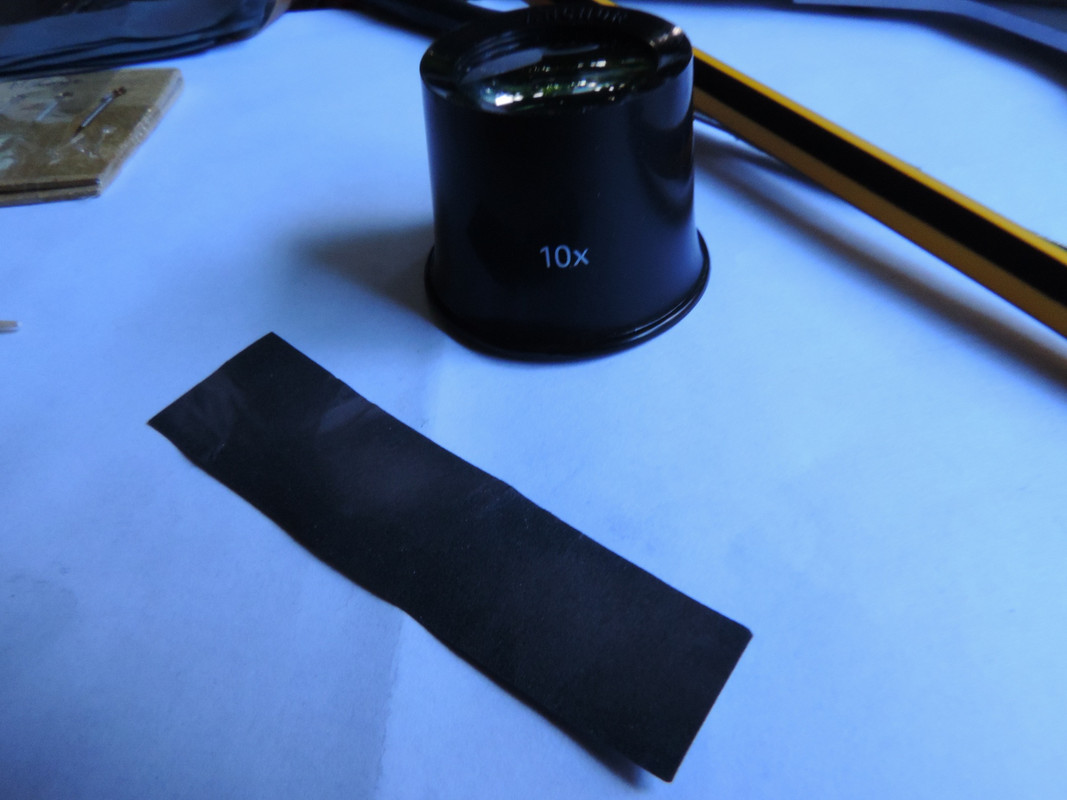
The first step is brushing away the gold plating. Swipe carefully from top to bottom starting with 600 grit.
Almost done, if you look closely you can see some of the plating has not been completely removed.

You might want to leave a few uneven spots, they will help to obtain a more natural result, especially of you want a very aged look.
Now you need to restore the shine of the hands. Switch to finer sandpaper increasing all the way up to 5000.
To give it a good shine you must sand in both directions, just don't press too much and try not to bend the hands.
You should end up with something like this:
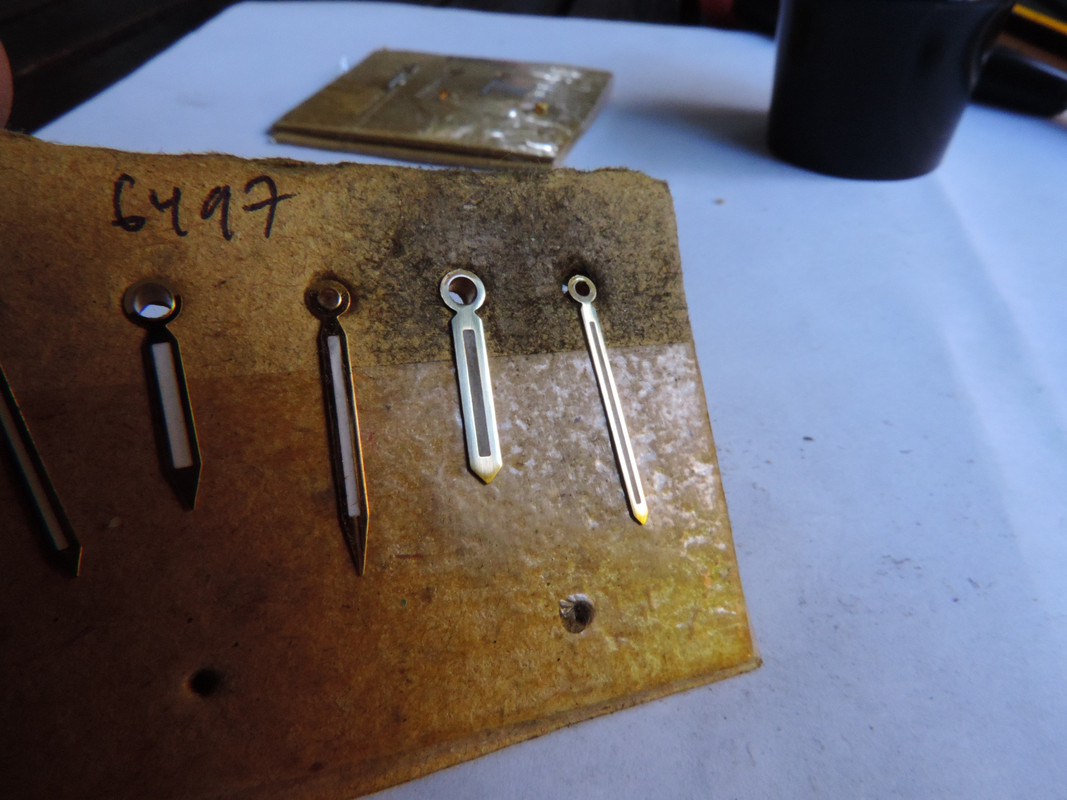
Now it's time to boil some eggs
Place the hands in suitable plastic box with the eggs (I used two), then smash the eggs and seal the box. Leave them there for a few minutes.
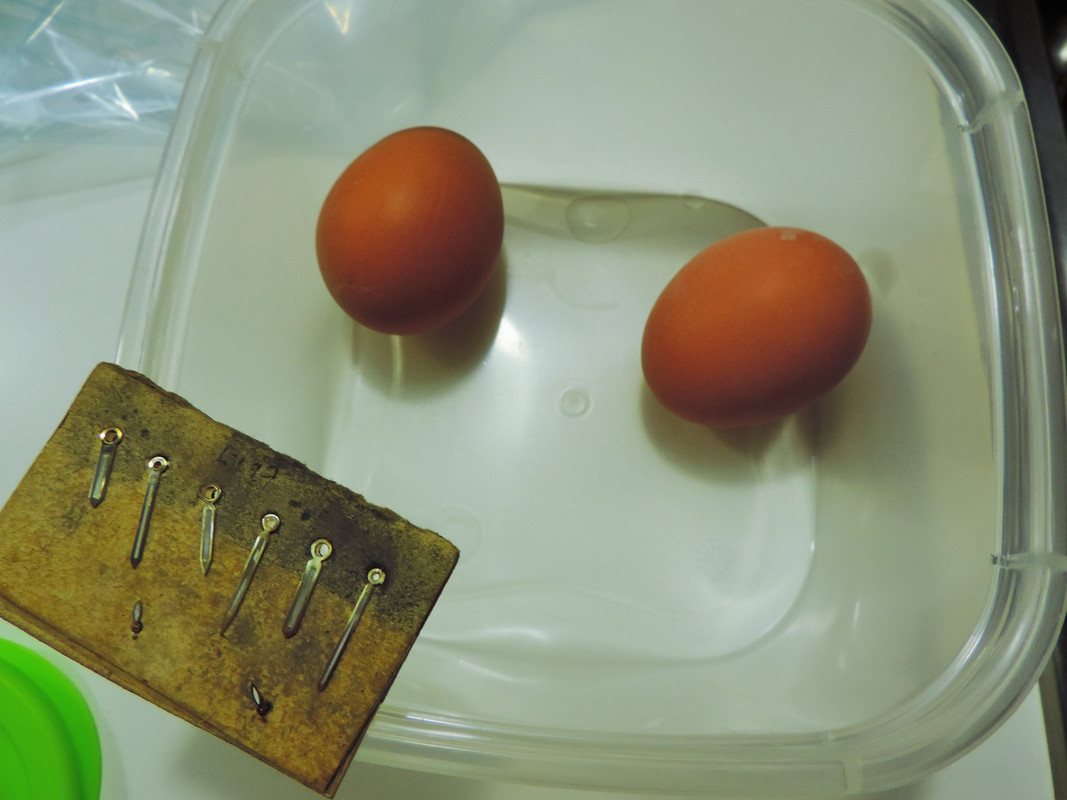
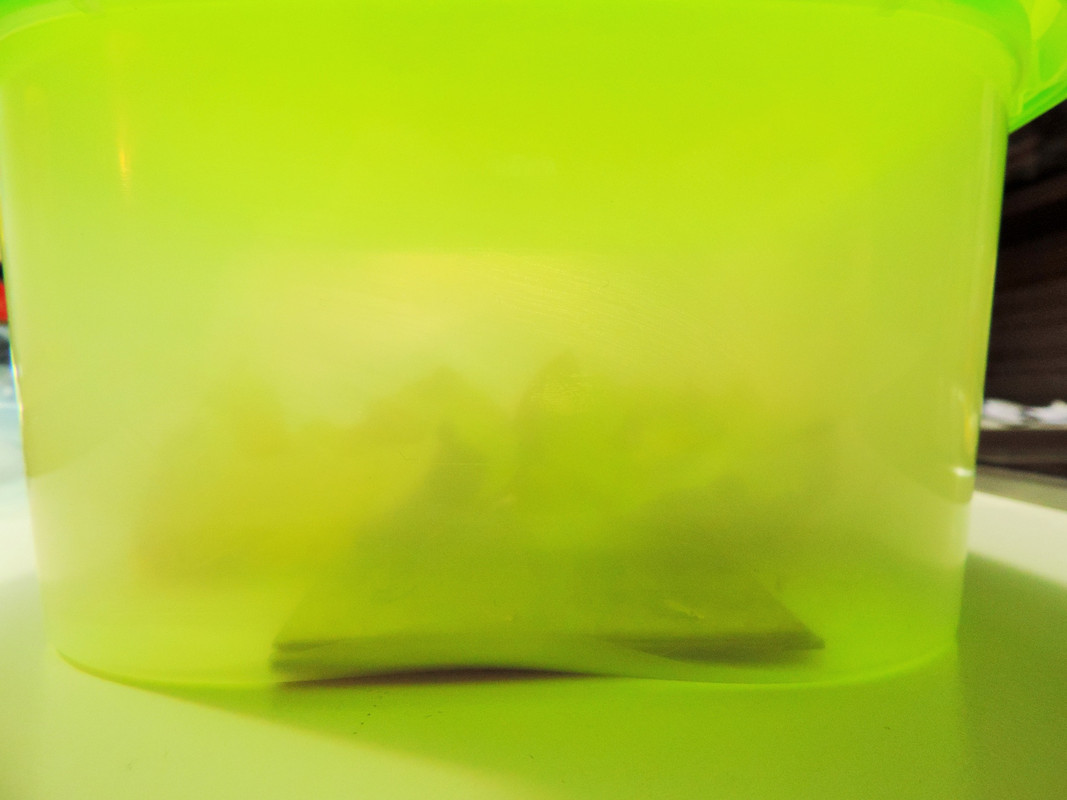
Here's how they look once out of the plastic box:
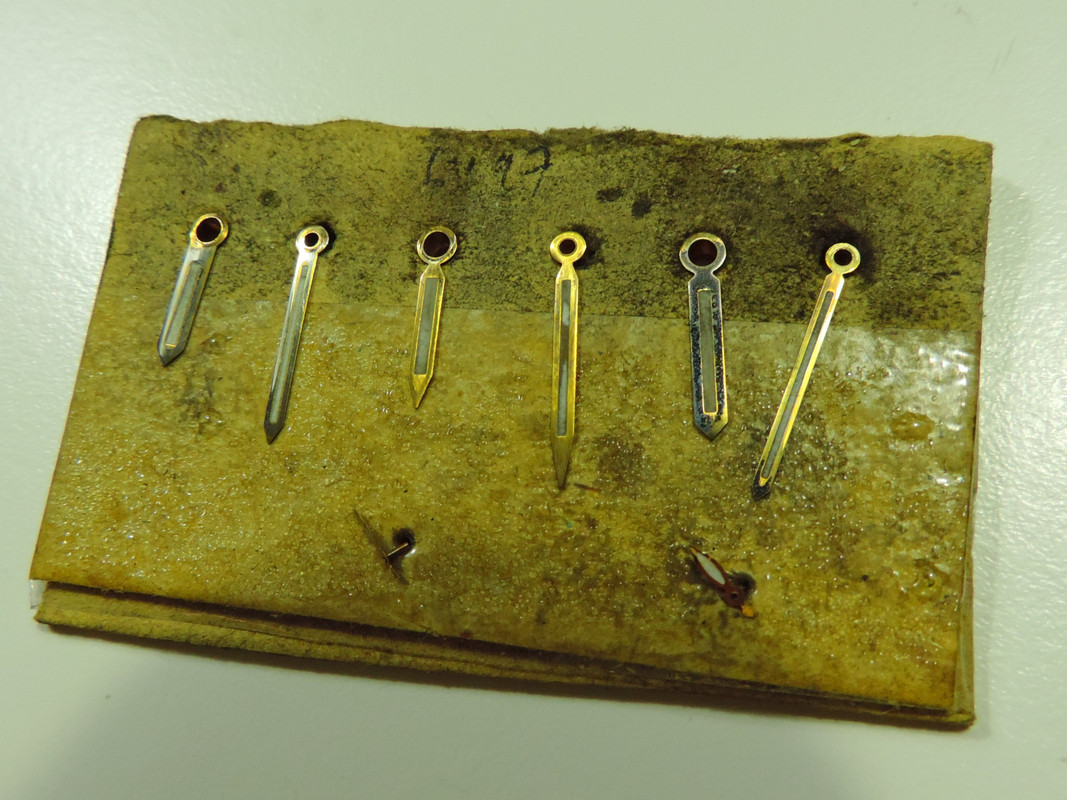
Now it's time for something different. I use a compund called AK159 metal burnishing, it's available on ebay.
What it does is oxidizing metal, depending on the time of exposure and how much of it you will remove after it dried the result may vary from completely black patina to various degrees of rust.
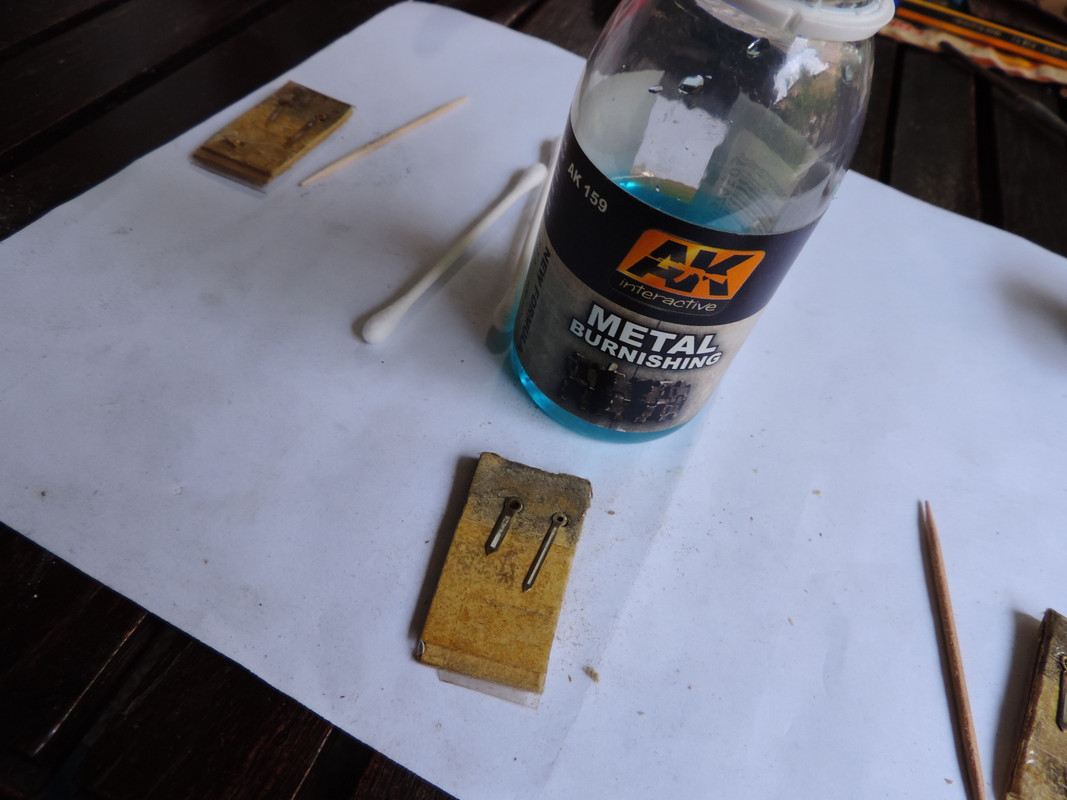
As you can see, the angelus curved hands are made of steel instead of brass and the reaction is a bit different.
Here they are after a few seconds of exposure:
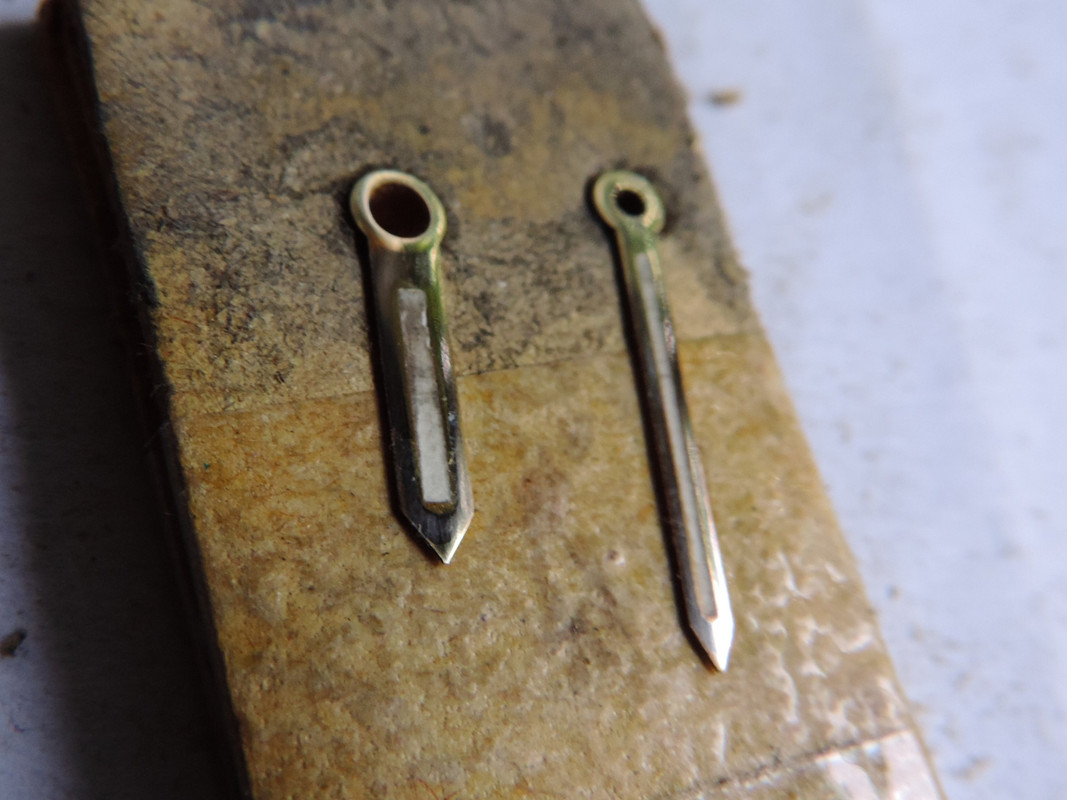
And after a few more:
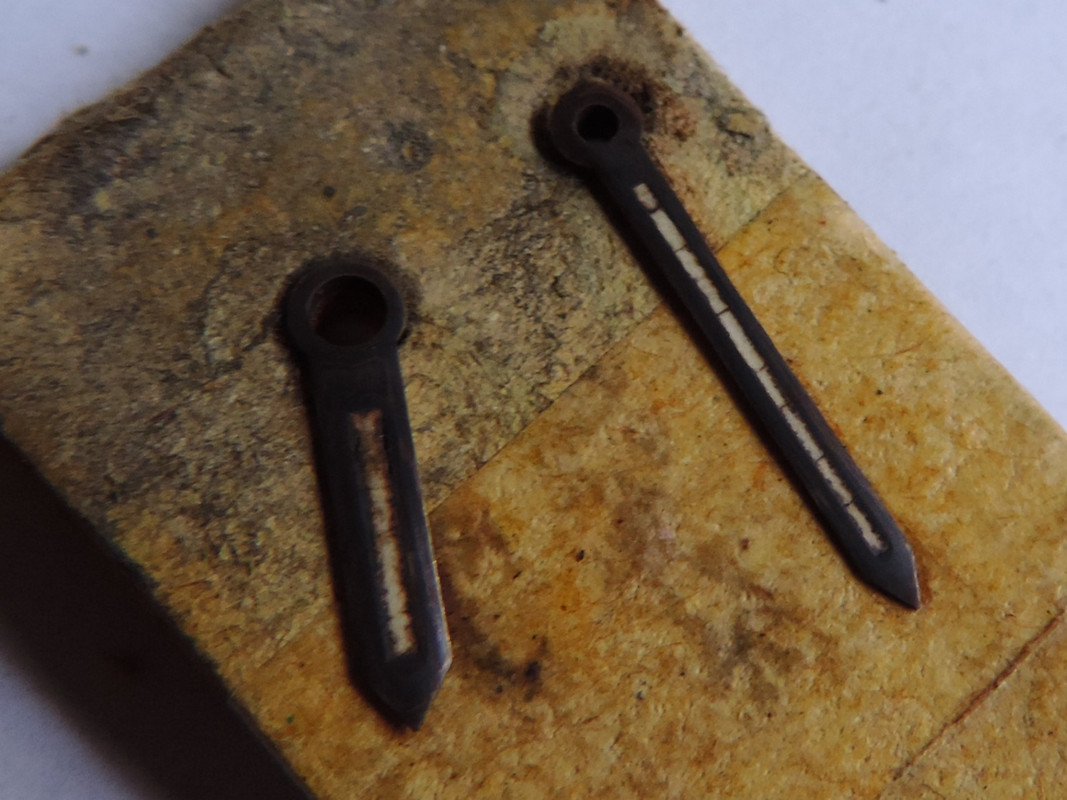
I left the compound work for about three-five minutes then cleaned with a paper cloth and removed most of the patina with some fine sandpaper (1000 grit). I had to experiment a bit here, every time the result is different, but you can clean and restart every time you wish.
Wide hands have been treated as well:
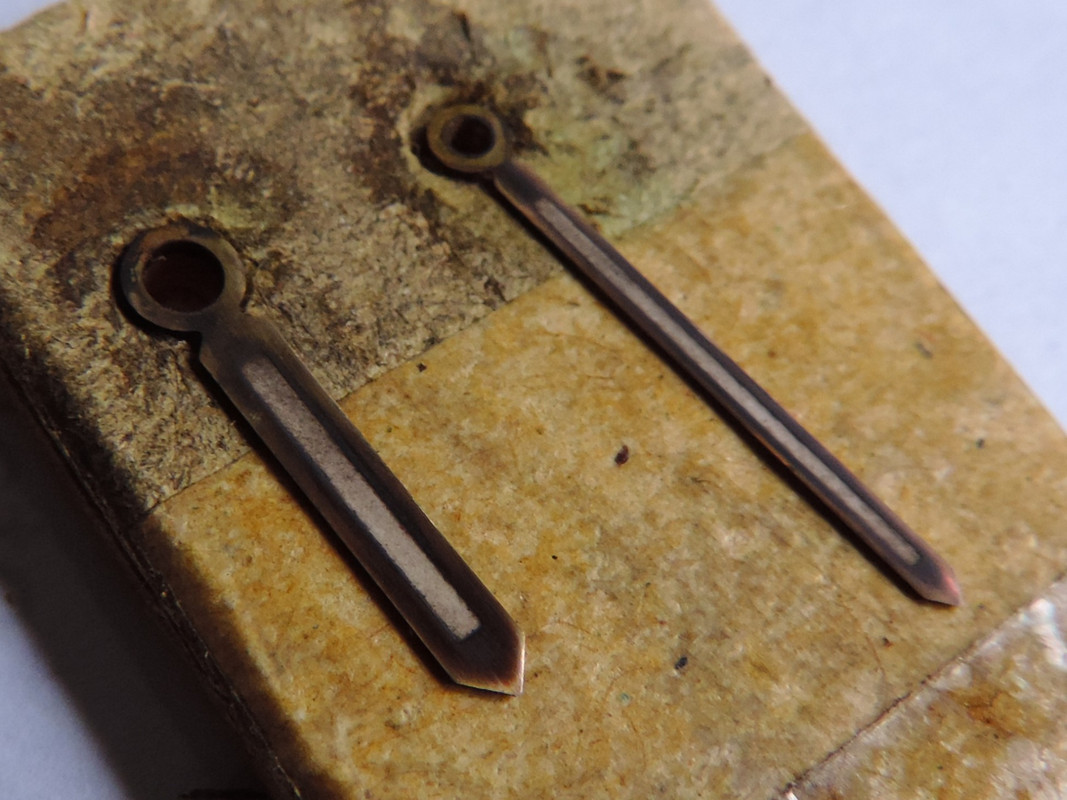
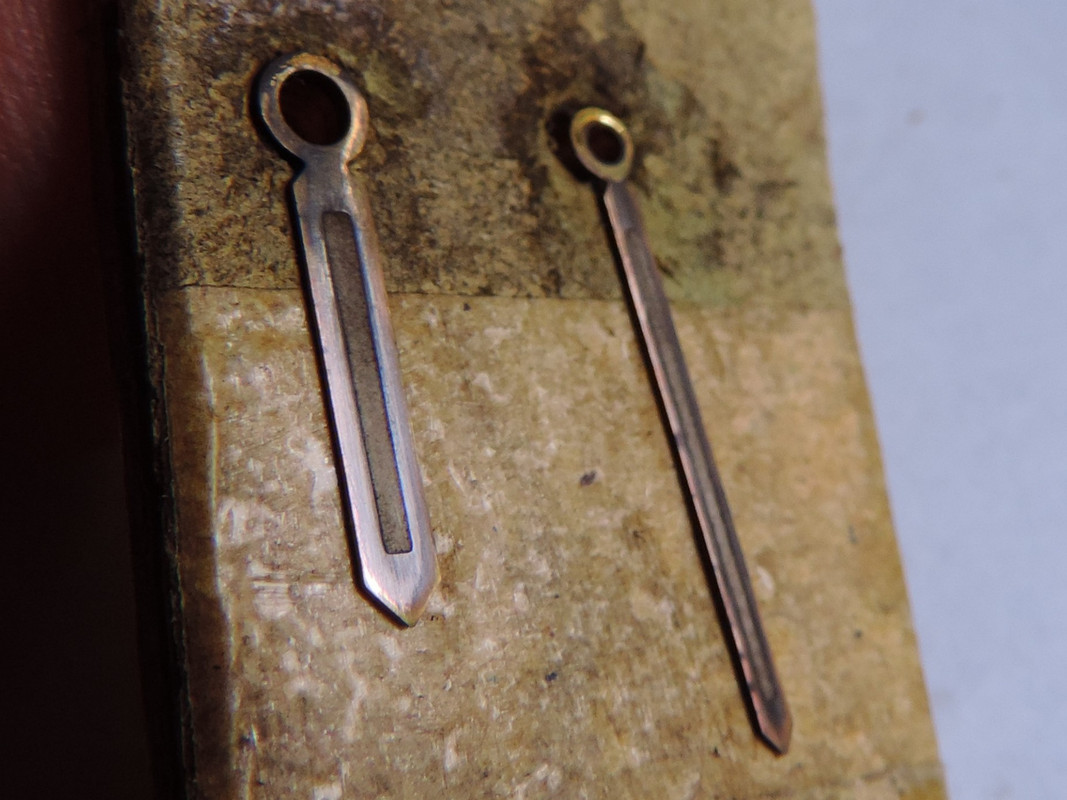
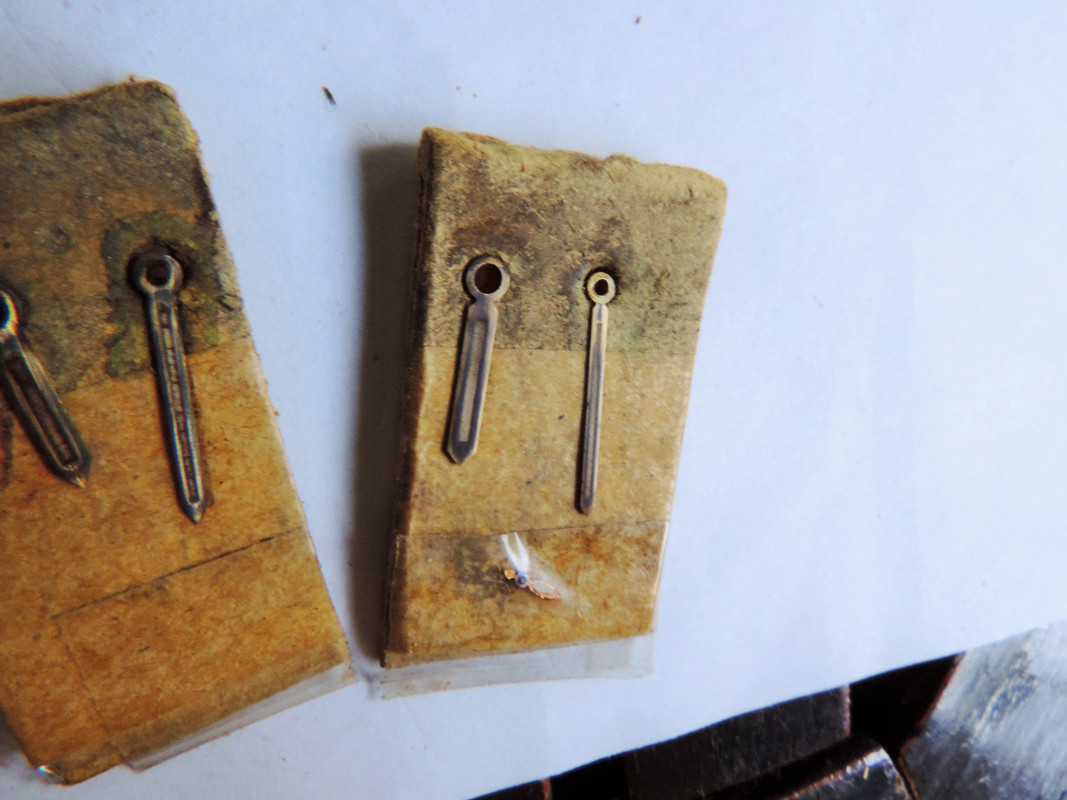
I did not threat double pencil hands with the burnishing compound, they came out of the egg box already looking good but the lume was still too white.
Here's where your coffee cup becomes useful.
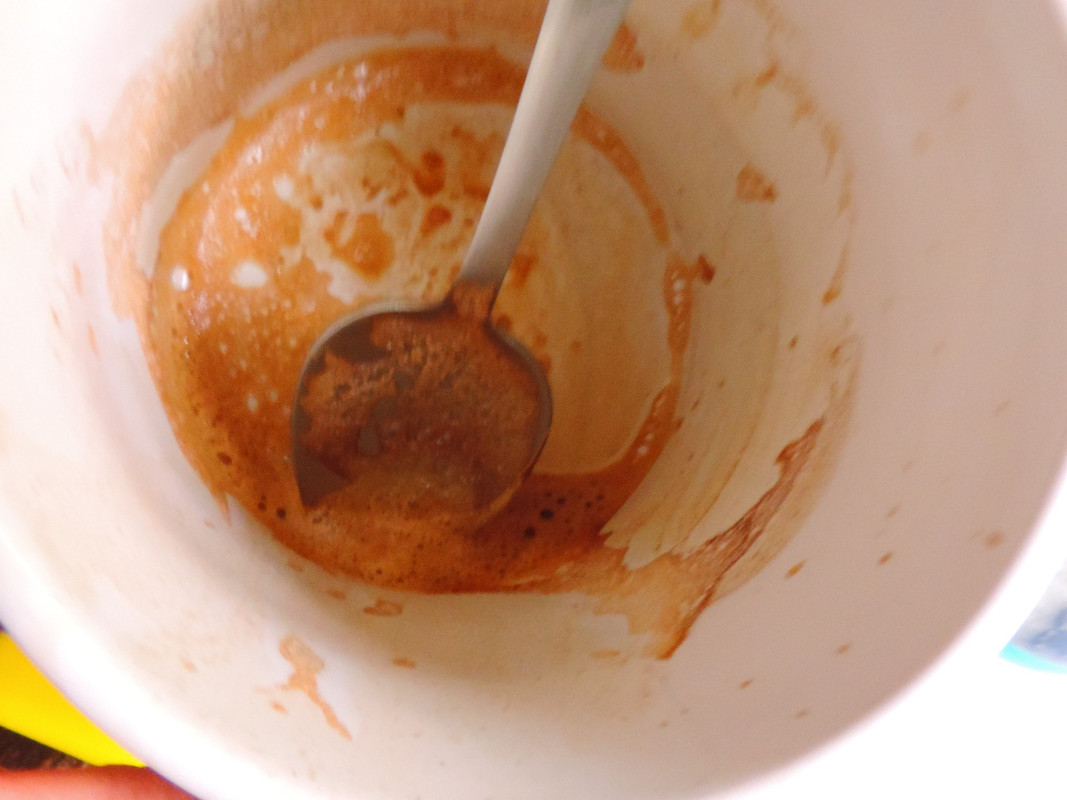
I grabbed a cotton stick, dropped in the semi-dried coffee residue and swiped the stick on the hands. I also added some soot when lume was wet with coffee. Blew away excess and cleaned with paper tissue.
Here's how they look now:
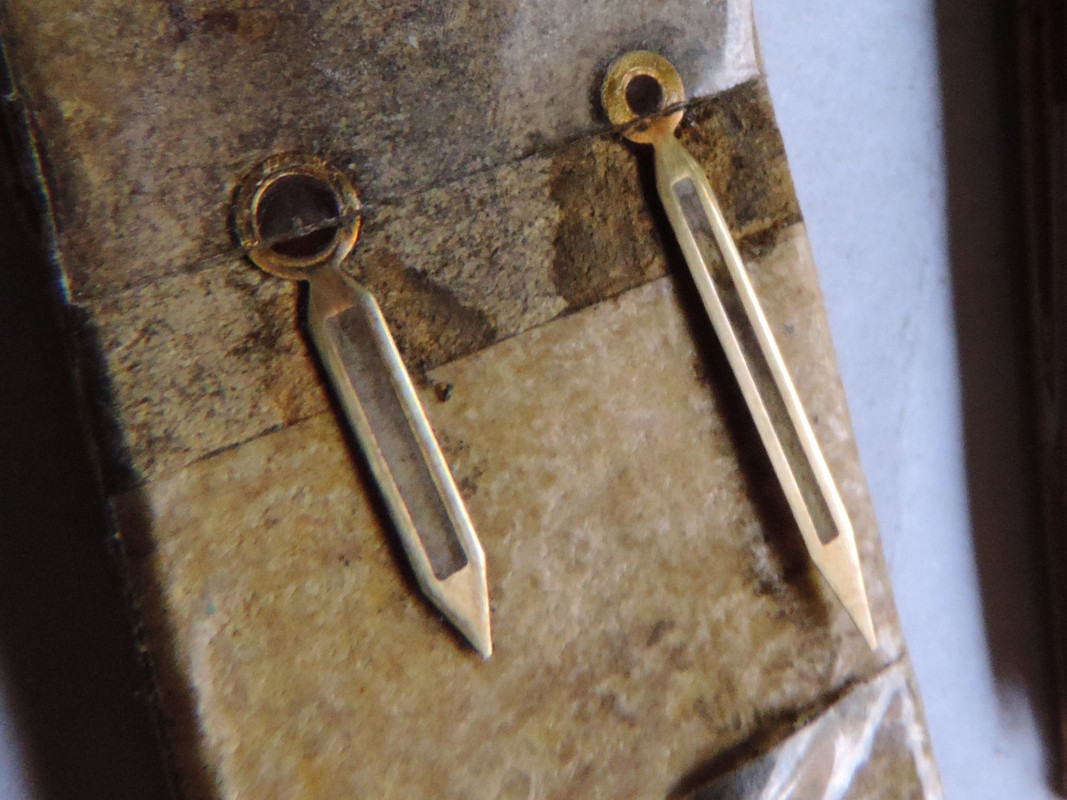
And the others, all (partially) cleaned. Sorry for the out of focus pic:
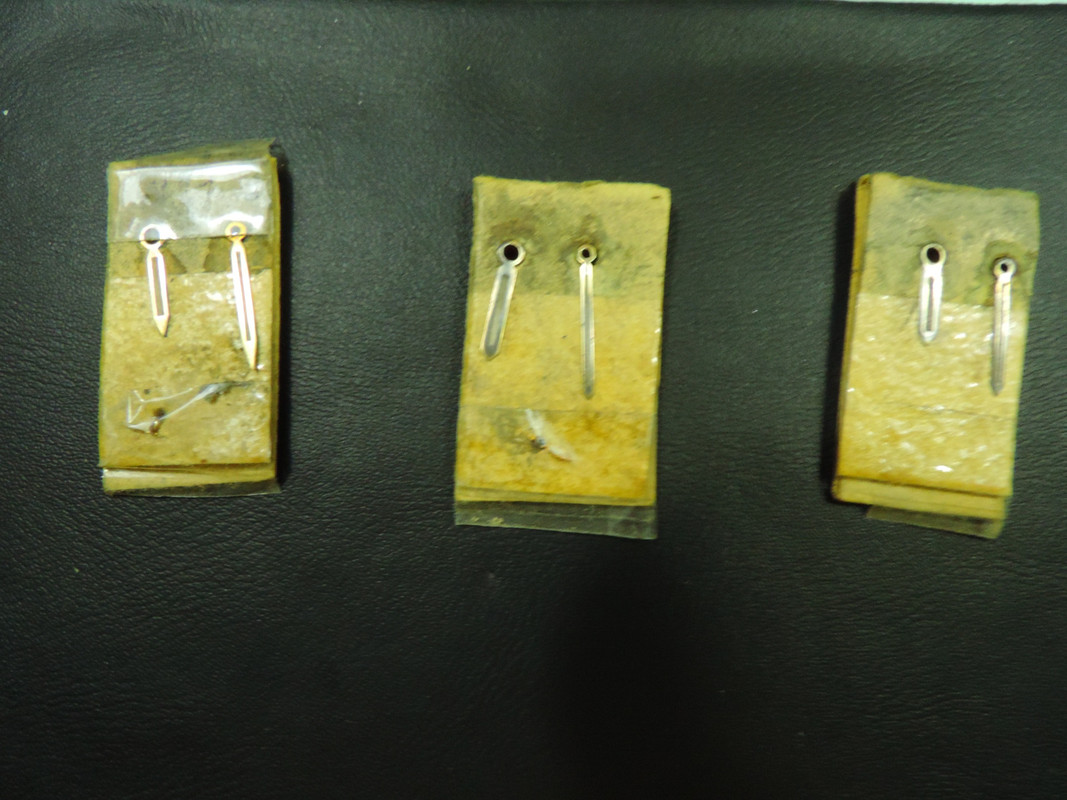
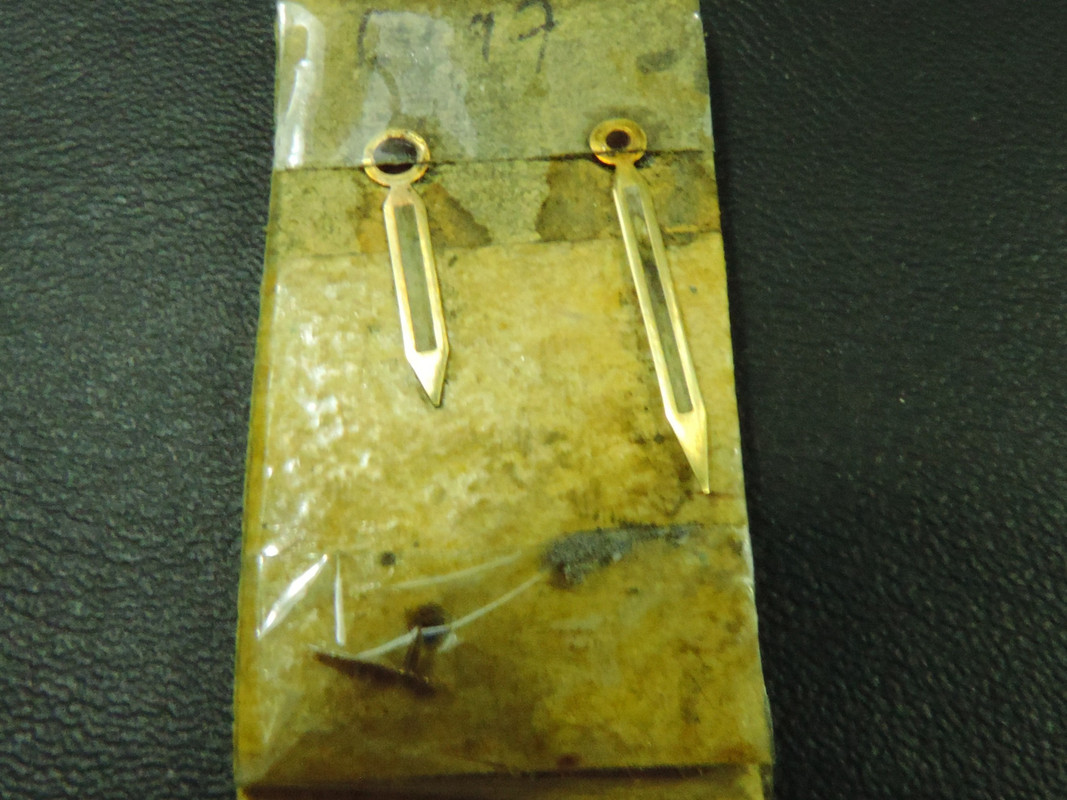
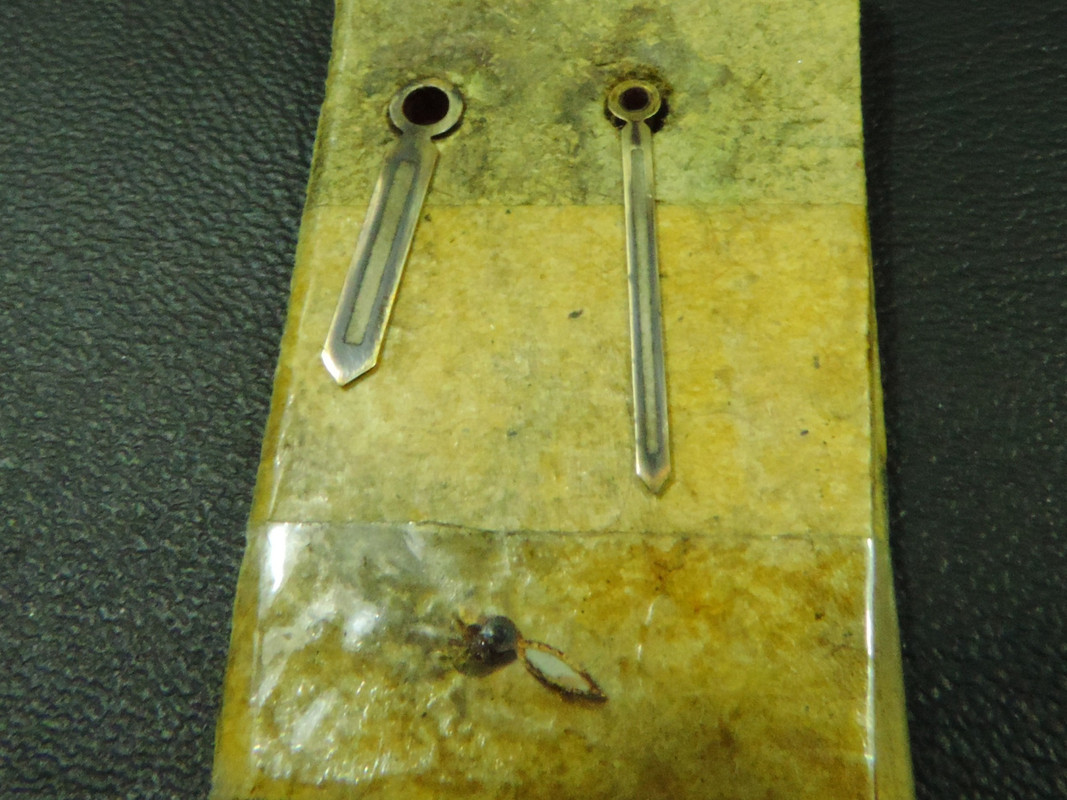
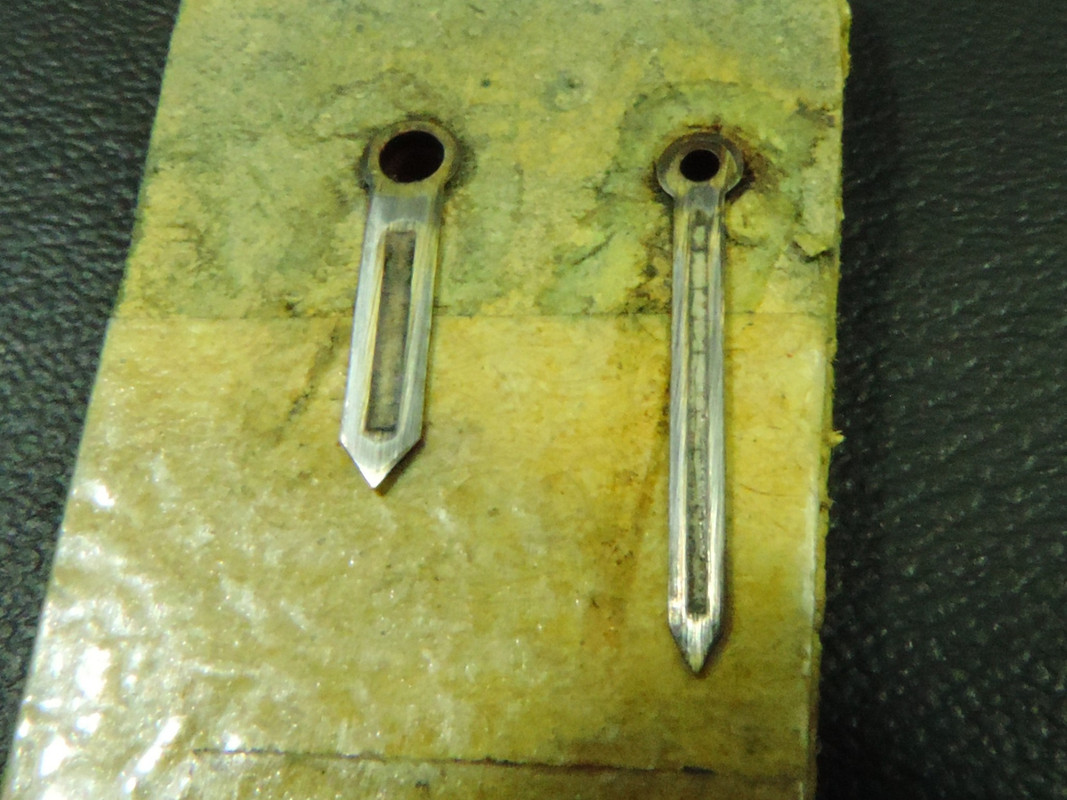
Ok, we're almost done.
Let the hands have another boiled egg tour. I used a plastic bag this time instead of the box, it's easier to check the result often without opening it.
Once out of the bag, a final very light clean with tissue and here's the final result:
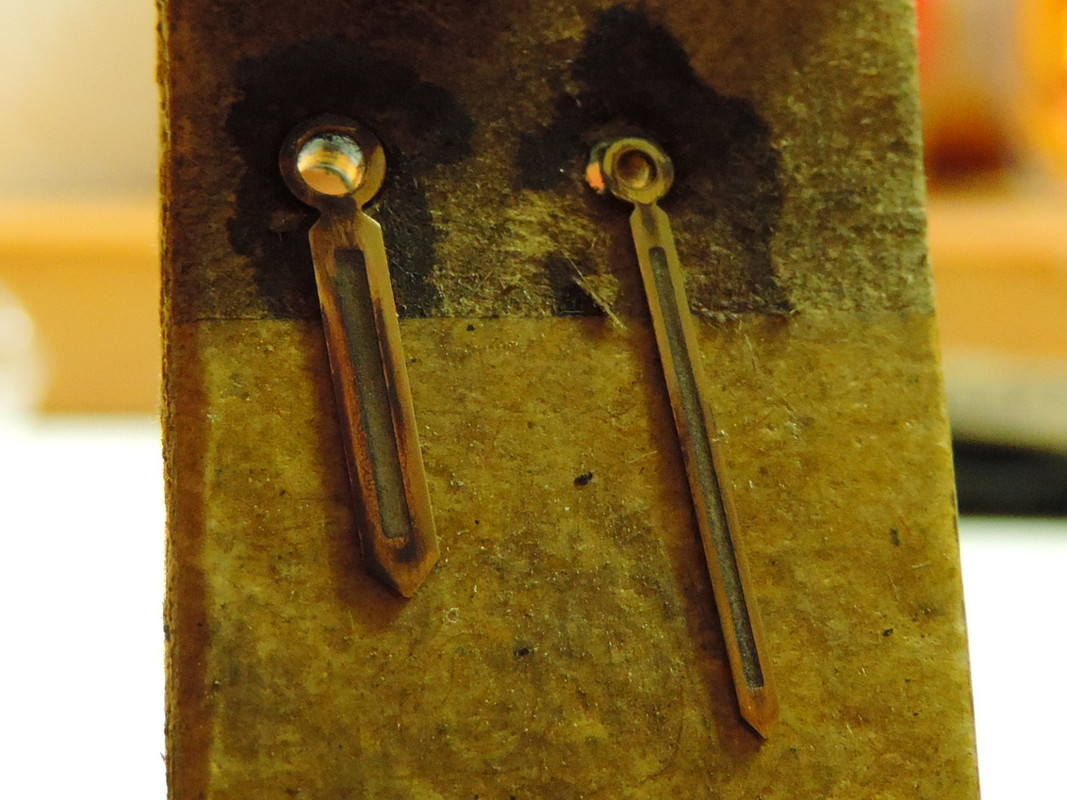
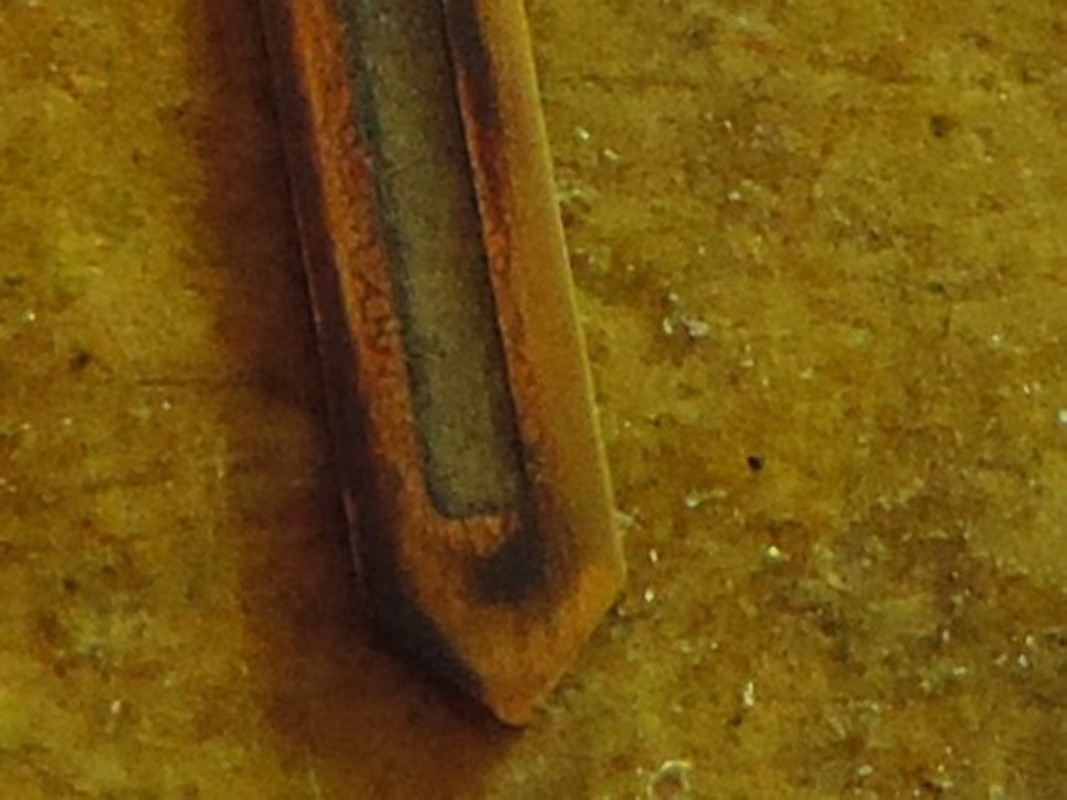
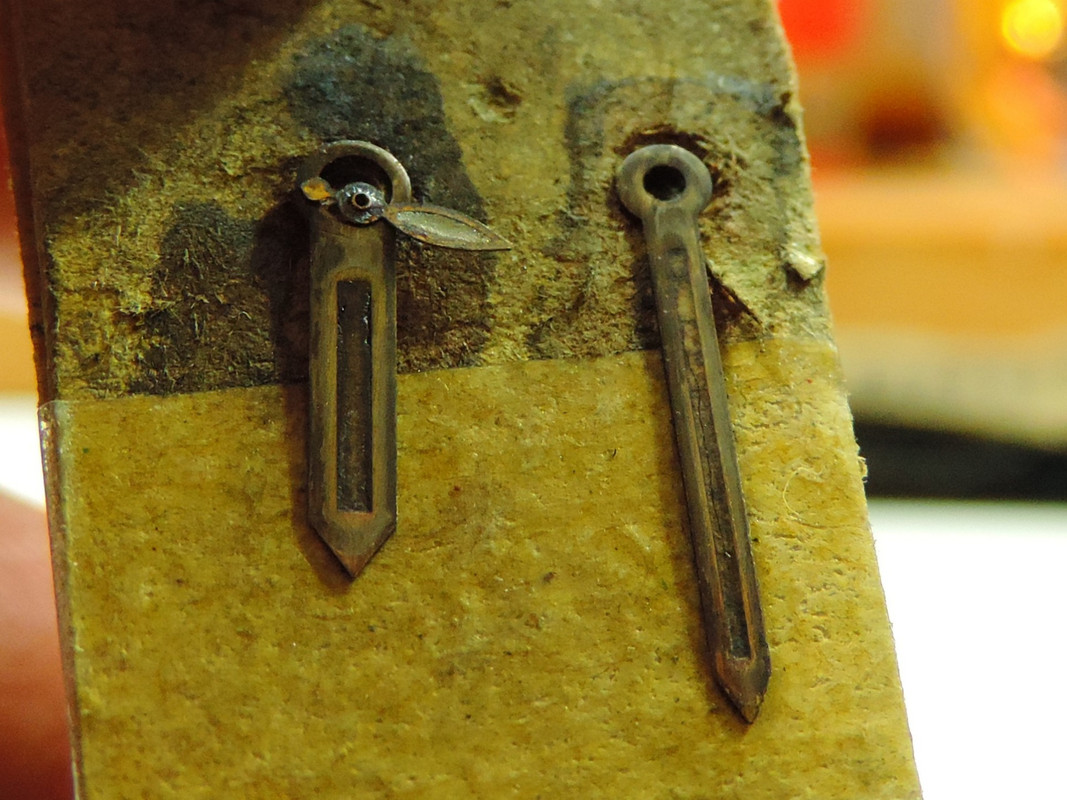
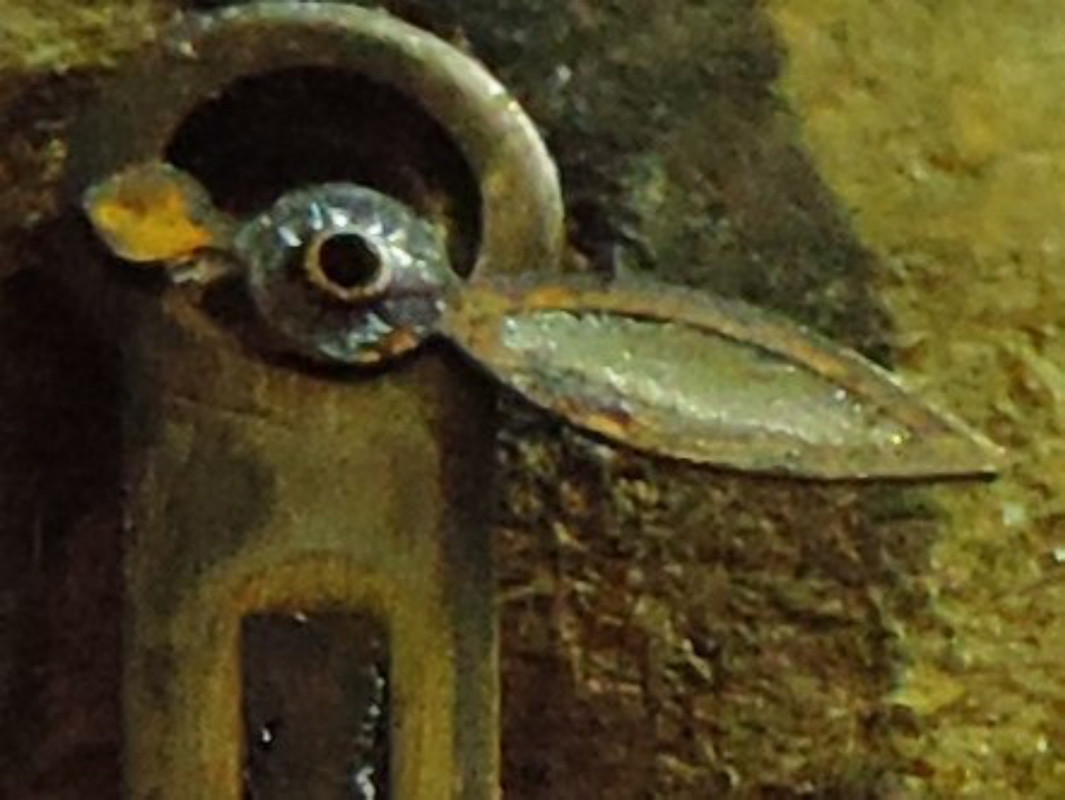
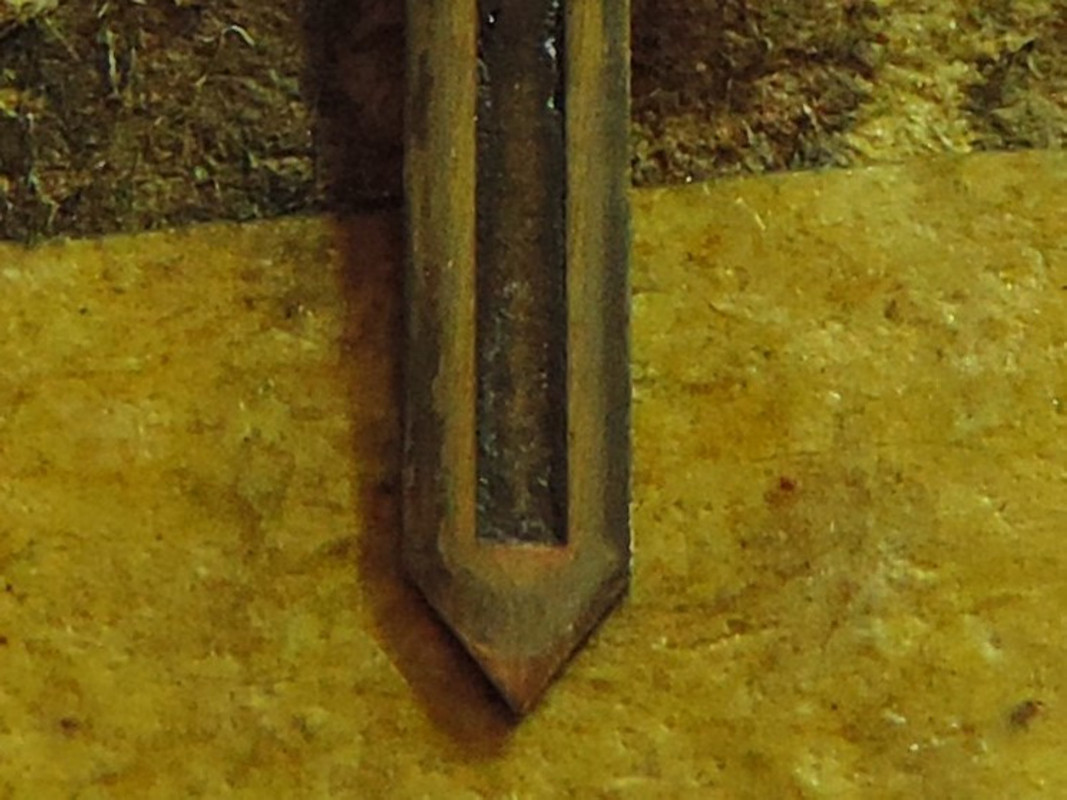
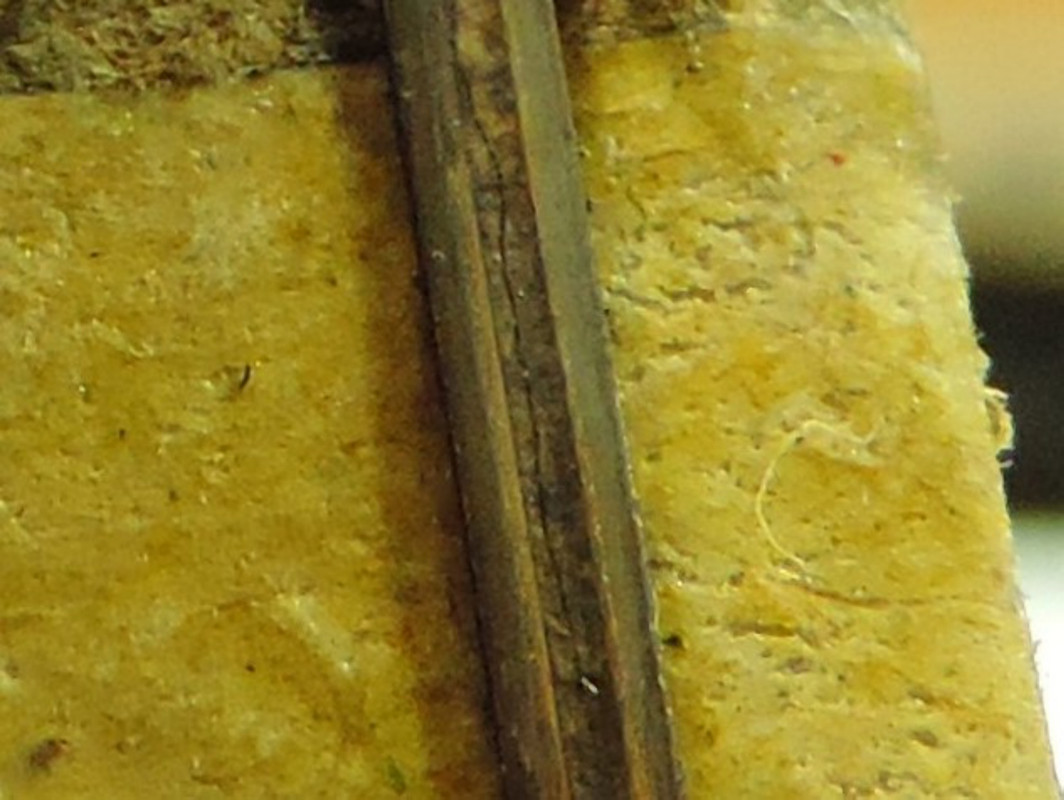

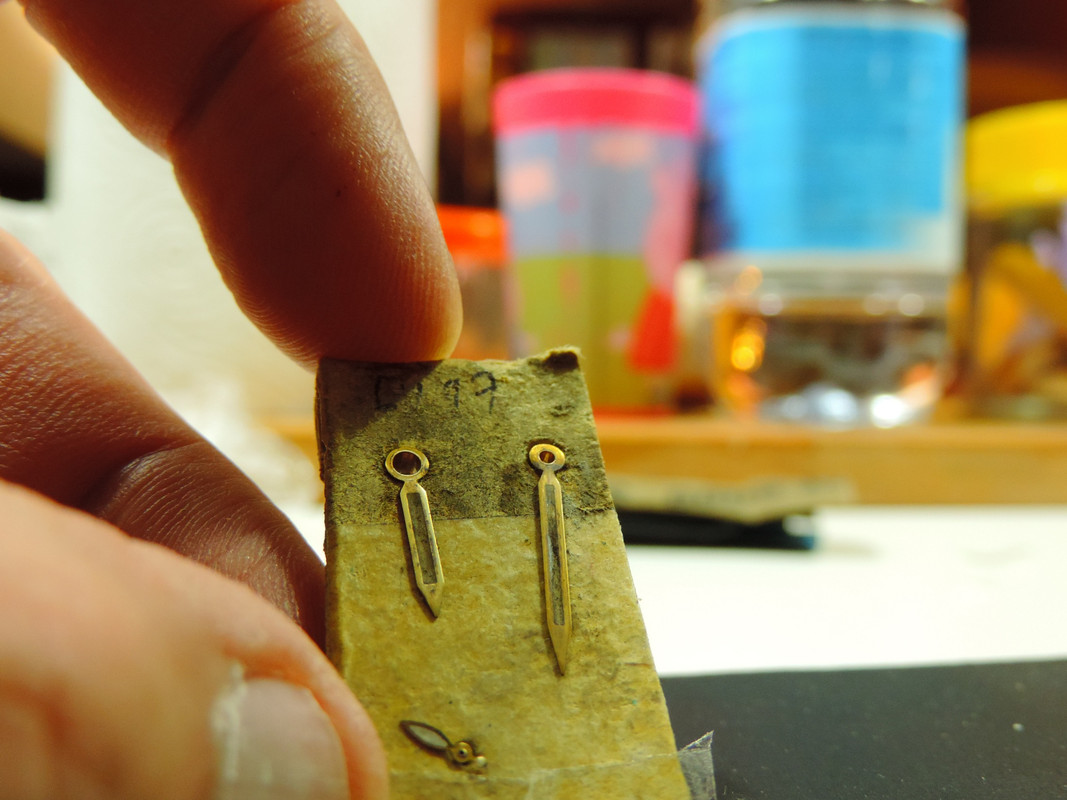
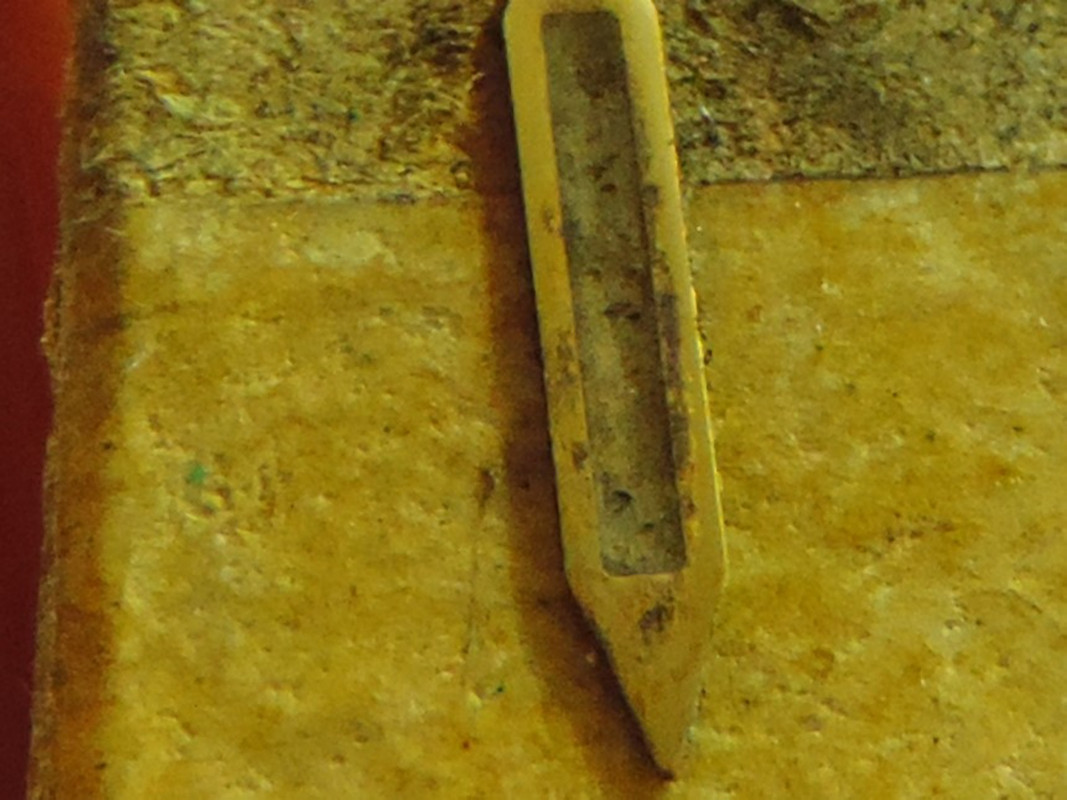
Final notes
As you surely imagine, this is mostly an empirical process. It is very important to stop and check carefully after each and every step how the look evolves and decide based on experience what next step is best.
Some hands may need all these steps, some may need only a few of them, and some may need more.
It also very important that you decide which look you want to get before you start.
Here are a few short tips to help you during your experimentations:
- Basically egg darkens brass and makes it a warmer color.
- Brushed surface gets patina more easily.
- Perfect removal of plating is fundamental for an even color change.
- On the other hand if you want a very aged/damaged look, areas where the plating hasn't come off completely will age differently and create a natural effect.
Hope you found the read useful, now try it yourself!
I do like building and I do like to shoot pics of watches, luckily for me that's something appreciated on the forums I partecipate, but I felt it still was not enough.
Now, I'm very far from a pro and my experience is quite limited, but some members showed interest in the process I use to age hands so I thought, why not document it?
Here's my effort to explain what I do to those hands and how bad do I treat 'em. I hope it might be useful for new members approaching this hobby.
Let's start
Before anything else, grab a cup of coffee. It's good and you will need it later

Here's a set of Athaya tall tube hands, we have curved angelus hands, pencil hands and wide hands. This is how they look OOB:

Some "tools" you will need:
- Toothpicks (imho the most essential watchmaker's tool)
- Sandpaper in increasing grades from 180 to 5000 grit cut in small stripes
- A 10x loupe


The first step is brushing away the gold plating. Swipe carefully from top to bottom starting with 600 grit.
Almost done, if you look closely you can see some of the plating has not been completely removed.

You might want to leave a few uneven spots, they will help to obtain a more natural result, especially of you want a very aged look.
Now you need to restore the shine of the hands. Switch to finer sandpaper increasing all the way up to 5000.
To give it a good shine you must sand in both directions, just don't press too much and try not to bend the hands.
You should end up with something like this:

Now it's time to boil some eggs
Place the hands in suitable plastic box with the eggs (I used two), then smash the eggs and seal the box. Leave them there for a few minutes.


Here's how they look once out of the plastic box:

Now it's time for something different. I use a compund called AK159 metal burnishing, it's available on ebay.
What it does is oxidizing metal, depending on the time of exposure and how much of it you will remove after it dried the result may vary from completely black patina to various degrees of rust.

As you can see, the angelus curved hands are made of steel instead of brass and the reaction is a bit different.
Here they are after a few seconds of exposure:

And after a few more:

I left the compound work for about three-five minutes then cleaned with a paper cloth and removed most of the patina with some fine sandpaper (1000 grit). I had to experiment a bit here, every time the result is different, but you can clean and restart every time you wish.
Wide hands have been treated as well:



I did not threat double pencil hands with the burnishing compound, they came out of the egg box already looking good but the lume was still too white.
Here's where your coffee cup becomes useful.

I grabbed a cotton stick, dropped in the semi-dried coffee residue and swiped the stick on the hands. I also added some soot when lume was wet with coffee. Blew away excess and cleaned with paper tissue.
Here's how they look now:

And the others, all (partially) cleaned. Sorry for the out of focus pic:




Ok, we're almost done.
Let the hands have another boiled egg tour. I used a plastic bag this time instead of the box, it's easier to check the result often without opening it.
Once out of the bag, a final very light clean with tissue and here's the final result:









Final notes
As you surely imagine, this is mostly an empirical process. It is very important to stop and check carefully after each and every step how the look evolves and decide based on experience what next step is best.
Some hands may need all these steps, some may need only a few of them, and some may need more.
It also very important that you decide which look you want to get before you start.
Here are a few short tips to help you during your experimentations:
- Basically egg darkens brass and makes it a warmer color.
- Brushed surface gets patina more easily.
- Perfect removal of plating is fundamental for an even color change.
- On the other hand if you want a very aged/damaged look, areas where the plating hasn't come off completely will age differently and create a natural effect.
Hope you found the read useful, now try it yourself!
Last edited:
